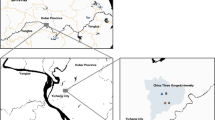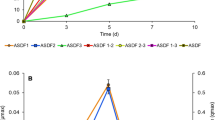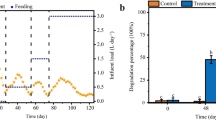Abstract
A simple consortium consisted of two members of Klebsiella sp. A1 and Comamonas sp. A2 was isolated from the sewage of a pesticide mill in China. One member of Klebsiella sp. A1 is a novel strain that could use atrazine as the sole carbon and nitrogen source. The consortium showed high atrazine-mineralizing efficiency and about 83.3% of 5 g l−1 atrazine could be mineralized after 24 h degradation. Contrary to many other reported microorganisms, the consortium was insensitive to some nitrogenous fertilizers commonly used, not only in presence of 200 mg l−1 atrazine but also in 5 g l−1 atrazine mediums. After 24 h incubation, 200 mg l−1 atrazine was completely mineralized despite of the presence of urea, (NH4)2CO3 and (NH4)2HPO4 in the medium. Very minor influence was observed when NH4Cl was added as additional nitrogen source. Advantages of the simple consortium, high mineralizing efficiency and insensitivity to most of exogenous nitrogen sources, all suggested application potential of the consortium for the bioremediation of atrazine-contaminated soils and waters.






Similar content being viewed by others
References
Abdelhafid R, Houot S, Barriuso E (2000a) Dependence of atrazine degradation on C and N availability in adapted and non-adapted soils. Soil Biol Biochem 32:389–401
Abdelhafid R, Houot S, Barriuso E (2000b) How increasing availabilities of carbon and nitrogen affect atrazine behaviour in soils. Biol Fertil Soils 30:333–340
Alvey S, Crowley DE (1995) Influence of organic amendments on biodegradation of atrazine as a nitrogen-source. J Environ Qual 24:1156–1162
Assaf NA, Turco RF (1994) Accelerated biodegradation of atrazine by a microbial consortium is possible in culture and soil. Biodegradation 5:29–35
Bergey DH, Holt JG (1994) Bergey’s manual of determinative bacteriology, 9th edn. Williams & Wilkins, Baltmore
Bouquard C, Ouazzani J, Prome JC, MichelBriand Y, Plesiat P (1997) Dechlorination of atrazine by a Rhizobium sp. isolate. Appl Environ Microbiol 63:862–866
de Souza ML, Newcombe D, Alvey S, Crowley DE, Hay A, Sadowsky MJ, Wackett LP (1998a) Molecular basis of a bacterial consortium: interspecies catabolism of atrazine. Appl Environ Microbiol 64:178–184
de Souza ML, Seffernick J, Martinez B, Sadowsky MJ, Wackett LP (1998b) The atrazine catabolism genes atzABC are widespread and highly conserved. J Bacteriol 180:1951–1954
de Souza ML, Wackett LP, Sadowsky MJ (1998c) The atzABC genes encoding atrazine catabolism are located on a self-transmissible plasmid in Pseudomonas sp. strain ADP. Appl Environ Microbiol 64:2323–2326
Eaton RW, Karns JS (1991) Cloning and analysis of s-triazine catabolic genes from Pseudomonas sp. strain NRRLB-12227. J Bacteriol 173:1215–1222
Entry JA, Mattson KG, Emmingham WH (1993) The influence of nitrogen on atrazine and 2,4-dichlorophenoxyacetic acid mineralization in grassland soils. Biol Fertil Soils 16:179–182
Garcia-Gonzalez V, Govantes F, Shaw LJ, Burns RG, Santero E (2003) Nitrogen control of atrazine utilization in Pseudomonas sp. strain ADP. Appl Environ Microbiol 69:6987–6993
Gebendinger N, Radosevich M (1999) Inhibition of atrazine degradation by cyanazine and exogenous nitrogen in bacterial isolate M91–3. Appl Microbiol Biotechnol 51:375–381
Mandelbaum RT, Wackett LP, Allan DL (1993) Mineralization of the s-triazine ring of atrazine by stable bacterial mixed cultures. Appl Environ Microbiol 59:1695–1701
Mandelbaum RT, Allan DL, Wackett LP (1995) Isolation and characterization of a Pseudomonas sp. that mineralizes the s-triazine herbicide atrazine. Appl Environ Microbiol 61:1451–1457
Mulbry WW, Zhu H, Nour SM, Topp E (2002) The triazine hydrolase gene trzN from Nocardioides sp. strain C190: cloning and construction of gene-specific primers. FEMS Microbiol Lett 206:75–79
Piutti S, Semon E, Landry D, Hartmann A, Dousset S, Lichtfouse E, Topp E, Soulas G, Martin-Laurent F (2003) Isolation and characterisation of Nocardioides sp. SP12, an atrazine-degrading bacterial strain possessing the gene trzN from bulk and maize rhizosphere soil. FEMS Microbiol Lett 221:111–117
Radosevich M, Traina SJ, Hao YL, Tuovinen OH (1995) Degradation and mineralization of atrazine by a soil bacterial isolate. Appl Environ Microbiol 61:297–302
Rhine ED, Fuhrmann JJ, Radosevich M (2003) Microbial community responses to atrazine exposure and nutrient availability: linking degradation capacity to community structure. Microb Ecol 46:145–160
Rousseaux S, Hartmann A, Soulas G (2001) Isolation and characterisation of new Gram-negative and Gram-positive atrazine degrading bacteria from different French soils. FEMS Microbiol Ecol 36:211–222
Sambrook J, Fritsch EF, Maniatis T (1989) Molecular cloning: a laboratory manual, 2nd edn. Cold Spring Harbor Laboratory Press, Cold Spring Harbor
Schiavon M (1988) Studies of the leaching of atrazine, of its chlorinated derivatives, and of hydroxyatrazine from soil using C-14 ring-labeled compounds under outdoor conditions. Ecotoxicol Environ Saf 15:46–54
Smith D, Alvey S, Crowley DE (2005) Cooperative catabolic pathways within an atrazine-degrading enrichment culture isolated from soil. FEMS Microbiol Ecol 53:265–273
Strong LC, Rosendahl C, Johnson G, Sadowsky MJ, Wackett LP (2002) Arthrobacter aurescens TC1 metabolizes diverse s-triazine ring compounds. Appl Environ Microbiol 68:5973–5980
Struthers JK, Jayachandran K, Moorman TB (1998) Biodegradation of atrazine by Agrobacterium radiobacter J14a and use of this strain in bioremediation of contaminated soil. Appl Environ Microbiol 64:3368–3375
Topp E, Mulbry WM, Zhu H, Nour SM, Cuppels D (2000) Characterization of s-triazine herbicide metabolism by a Nocardioides sp. isolated from agricultural soils. Appl Environ Microbiol 66:3134–3141
Weightman A, Slater J (1988). The problem of xenobiotics and recalcitrance. In: Lynch J, Hobbie J (eds) Microorganisms in action: concepts and applications in microbial ecology. Blackwell, Oxford, pp 322–347
Yanzekontchou C, Gschwind N (1994) Mineralization of the herbicide atrazine as a carbon source by a Pseudomonas strain. Appl Environ Microbiol 60:4297–4302
Acknowledgments
This work was partially supported by the grants from National Natural Science Foundation of China (grant numbers: 30821005 and 20777051), National High Technology Research and Development Program of China (grant numbers: 2007AA061101 and 2007AA10Z401) and National Basic Research Program of China (grant number: 2009CB118906).
Author information
Authors and Affiliations
Corresponding author
Rights and permissions
About this article
Cite this article
Yang, C., Li, Y., Zhang, K. et al. Atrazine degradation by a simple consortium of Klebsiella sp. A1 and Comamonas sp. A2 in nitrogen enriched medium. Biodegradation 21, 97–105 (2010). https://doi.org/10.1007/s10532-009-9284-9
Received:
Accepted:
Published:
Issue Date:
DOI: https://doi.org/10.1007/s10532-009-9284-9




